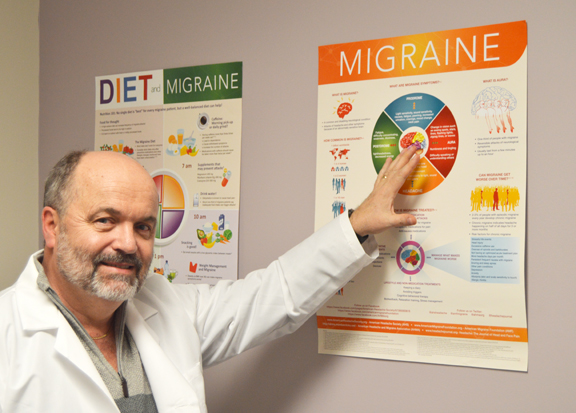Excerpt from Anne Mozingo’s article in Seacoast Sunday’s January 21, 2018 edition. Read the complete article here.
For more information, or to schedule an appointment with Dr. Knox, please call Neurology Associates of York Hospital at (207) 351-3987.
It is estimated between 30 million and 40 million Americans suffer from migraine headaches. Although many treatments are available, some chronic migraine sufferers have found relief by receiving Botox injections, popular for softening fine lines and wrinkles.
To qualify for Botox treatment, a patient needs to be labeled a chronic migraine sufferer, someone who has 15 severe headache days each month, said York Hospital neurologist Tony Knox, Ph.D., MD, a specialist in headache medicine who is fellowship trained in neuromuscular disease.
“A Canadian plastic surgeon suggested (Botox) be used to prevent headaches after his patient receiving treatment for wrinkles said it also helped reduce headaches. They did the studies and were able to demonstrate it does reduce the number of headaches. People with chronic migraines, 15 headache days a month, can find improvement toward eight to nine headache days a month,” said Knox, who is one of a very few doctors offering this treatment in Maine.
Botox, a neurotoxin derived from the bacterium Clostridium botulinum, works by temporarily immobilizing muscle activity by blocking nerve-muscle communication. It was originally used to help those with eye movement disorders that caused crossed-eyes. Knox said the uses for Botox continue to grow, with new uses being studied and approved regularly, such as over-active bladders, excessive eye closure and facial spasms and excessive sweating, among other uses.
“We inject it into the muscle. Not only does it paralyze small portions of the muscle, but it also is taken into nerve fibers, so it reduces the activity of the nerve fibers, which is why it is helpful in managing migraines,” said Knox, one of the pioneers in using this treatment more than a decade ago.
Knox was originally a skeptic at using the treatment for headaches, but he said some patients have been enthusiastic about the results and gradually he became a believer in the effectiveness in reducing the number of migraine days on some chronic migraine sufferers. The treatment is 31 small doses of Botox injected into the forehead, side and back of the head and the middle of the trapezius muscle on the shoulder. Though this is FDA approved and the administration of Botox requires specific training, side effects of the treatment include muscle weakness, droopy eyelids, difficulty swallowing and respiratory issues.
Patients can receive the treatment every 12 weeks, but Knox said it takes about a week to become active and generally lasts 10 weeks, though it varies with different people.
“At two weeks, the maximum effect takes place and starts wearing off. It’s a temporary, preventative treatment,” Knox said. “Some folks say I can’t remember not having a headache, and when they have the treatment they experience freedom. For some people, it’s like a religious experience. It’s quite humbling to be able to do that for people.”
This is not a one-size-fits-all treatment. Knox asks his patients to receive two cycles to determine the effectiveness. While some find relief, others are less enthusiastic.
“The effect varies on each person. I always temper my enthusiasm and sometimes people who have not had success with other medications come and ask me ’what about Botox,” he said.
Neurology Associates of York Hospital is a full-service headache clinic that is unique in that it offers acute treatment. Knox encourages patients to visit mid-migraine or early in the headache, when hydration, anti-nausea and headache medication can stop the migraine. Along with the latest migraine treatments, Neurology Associates offers other treatments, such as nerve blocks and trigger point injections for relaxing muscles in the neck.


